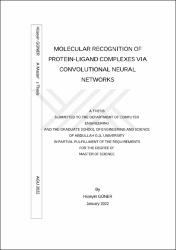| dc.contributor.author | Güner, Hüseyin | |
| dc.date.accessioned | 2022-09-01T11:13:29Z | |
| dc.date.available | 2022-09-01T11:13:29Z | |
| dc.date.issued | 2022 | en_US |
| dc.date.submitted | 2022-01 | |
| dc.identifier.uri | https://hdl.handle.net/20.500.12573/1366 | |
| dc.description.abstract | As a sub-discipline of Artificial Intelligence, deep neural networks have received
enormous interest in research and industrial applications over the last decades owing to
their highly successful performance in addressing and solving broad areas of problems.
Hence, especially hitherto achievements in computer-aided drug design brought an extra
impetus with the novel deep learning approaches in structure-based drug design etiology.
Our group offers a novel convolutional neural network model, deepMLR, that casts
insight into the molecular recognition of ligand molecules and a receptor protein
molecule. Having compared our model and a few other existing models with a case study
of a traditional approach, herein, we present the success story of a deep learning model
straight. | en_US |
| dc.description.abstract | Yapay Zeka'nın bir alt disiplini olarak derin sinir ağları, geniş spektrumdaki problem
alanlarını ele alma ve çözmedeki son derece başarılı performansları nedeniyle, son on
yılda (özellikle) araştırma ve endüstriyel uygulamalarda büyük bir ilgi görmeye başladı.
Özellikle son zamanlardaki, bilgisayar destekli ilaç tasarımındaki başarıları nedeniyle,
yapı tabanlı ilaç tasarımı etiyolojislerindeki yeni derin öğrenme yaklaşımlarına karşı
ekstra bir ivme kazanmıştır. Grubumuz, ligand moleküllerinin ve bir reseptör protein
molekülünün moleküler olarak tanınması hakkında bir fikir veren yeni bir konvolüsyonel
sinir ağı modeli sunmaktadır. Diğer mevcut modellerle ve modelimizle geleneksel bir
yaklaşımın örnek çalışmasıyla karşılaştırıldığında, burada derin bir öğrenme modelinin
başarı hikayesini sunuyoruz. | en_US |
| dc.description.tableofcontents | 1. INTRODUCTION .................................................................................................... 1
2. STRUCTURE BASED DRUG DISCOVERY........................................................ 3
2.1 MOLECULAR RECOGNITION ..................................................................................... 5
2.1.1 Thermodynamic Entities.................................................................................. 6
2.2 LIGAND-PROTEIN AFFINITY SCORING FUNCTIONS................................................... 7
2.3 MOLECULAR DYNAMICS SIMULATIONS ................................................................... 8
2.3.1 Force fields in protein-ligand complexes ........................................................ 9
2.4 THE MM/PBSA AND MM/GBSA METHODS............................................................ 9
3. DEEP LEARNING METHODS............................................................................ 11
3.1 ARTIFICIAL INTELLIGENCE IN DRUG DISCOVERY................................................... 11
3.1.1 Feed-forward neural networks ...................................................................... 12
3.1.2 Convolutional Neural Networks .................................................................... 16
4. EXPERIMENTAL RESULTS............................................................................... 20
4.1 COMPUTATIONAL RESOURCES ............................................................................... 20
4.2 CONVENTIONAL/TRADITIONAL SBDD CAMPAIGN ................................................ 20
4.2.1 Structural Data Files and Preparation for Docking Experiments ................ 20
4.2.2 Docking experiments...................................................................................... 22
4.2.3 MD Experiments............................................................................................ 24
4.3 A 3D CNN MODEL BY PAFNUCY............................................................................ 25
4.3.1 Datasets ......................................................................................................... 26
4.3.2 Architecture of the network............................................................................ 27
4.3.3 Training with Back-propagation ................................................................... 27
4.3.4 Results and metrics of back-propagation ...................................................... 28
4.3.5 Binding affinity of 2SHP with the leads......................................................... 30
4.4 OUR MODEL DEEPMLR......................................................................................... 30
4.4.1 Architecture of DeepMLR.............................................................................. 32
4.4.2 Training and evaluation of DeepMLR........................................................... 34
4.4.3 Evaluation Metrics......................................................................................... 35
4.4.4 Results of experiments run by DeepMLR....................................................... 35
5. CONCLUSIONS AND FUTURE PROSPECTS ................................................. 40
5.1 CONCLUSIONS ........................................................................................................ 40
5.2 SOCIETAL IMPACT AND CONTRIBUTION TO GLOBAL SUSTAINABILITY................... 41
5.3 FUTURE PROSPECTS ............................................................................................... 42
6. BIBLIOGRAPHY................................................................................................... 43 | en_US |
| dc.language.iso | eng | en_US |
| dc.publisher | Abdullah Gül Üniversitesi Fen Bilimleri Enstitüsü | en_US |
| dc.rights | info:eu-repo/semantics/openAccess | en_US |
| dc.subject | Molecular Recognition | en_US |
| dc.subject | Structure Based Drug Design | en_US |
| dc.subject | Deep Convolutional Neural Networks | en_US |
| dc.subject | Protein-Ligand Affinity Prediction | en_US |
| dc.subject | Structure Based Virtual Screening | en_US |
| dc.title | Molecular recognition of protein-ligand complexes via convolutional neural networks | en_US |
| dc.title.alternative | Protein-ligand komplekslerinin konvolüsyenel sinir ağları ile moleküler tanınması | en_US |
| dc.type | masterThesis | en_US |
| dc.contributor.department | AGÜ, Fen Bilimleri Enstitüsü, Elektrik ve Bilgisayar Mühendisliği Ana Bilim Dalı | en_US |
| dc.relation.publicationcategory | Tez | en_US |


















